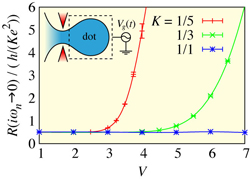Dynamic Response of a Mesoscopic Capacitor
Kato Group
Dynamic control of electronic states in nanostructures has recently stimulated renewed interest since it is demanded in application to quantum information technologies. Toward rapid manipulation of electronic states, it is required to understand dynamic properties of coherent transport phenomena in nanoscale devices. It, however, is quite recent that it has been realized to measure GHz-frequency response of a nanostructure, which is called a mesoscopic capacitor [1] (a quantum dot coupled to a lead and a gate electrode, see the inset of Fig. 1). This system is described by an effective RC circuit whose linear admittance takes the form G(ω) = (Rq-1/iωC)-1. Experimentally, the resistive element Rq (called relaxation resistance) can be determined by the low-frequency expansion G(ω)=-iωC+ω2C2Rq+O(ω3). In a classical circuit, Kirchhoff's law predicts that Rq should coincide with dc resistance RDC at the point contact (QPC). Surprisingly, the relaxation resistance Rq takes a universal value h/2e2 for single-mode transmission, which clearly differs from RDC=h/Te2 given by the Landauer formula with transmission probability T. This observation, indicating the breakdown of Kirchhoff's law, has been explained so far by the scattering theory proposed by Büttiker et al. [2] This theory, however, is based on the mean-field approximation, and is not justified in the presence of large charge fluctuation in the dot. Therefore, it remains an open question how electron correlation influences dynamic response of nanostructures.

Fig.1. Dynamic resistance as a function of reflection strength V at QPC. For K=1, it remains constant, while for K<1 it rapidly increases beyond a critical value of V. Inset, a schematic picture of the mesoscopic capacitor.
We have studied the effect of Coulomb repulsion by considering a one-dimensional electron model [3,4]. We have examined dynamic resistance of the mesoscopic capacitor by combining perturbation theory, renormalization group arguments, and Monte Carlo calculation. The perturbation theory with respect to reflection at the quantum point contact proves that dynamic resistance takes a universal value h/2Ke2 irrespective to reflection strength, where K is the Luttinger parameter. For intermediate and large reflection, however, drastic change in dynamic response has been found in the path-integral Monte Carlo calculation. We show the numerical result of the relaxation resistance on the charge-degenerate point at low temperatures in Fig. 1. One can see that for electron systems with no short-range repulsion (K=1) the relaxation resistance continues to take a universal value even for large reflection strength V at QPC. On the other hand, for electron systems with short-range repulsion (K<1), the relaxation resistance rapidly increases if V exceeds a critical value. This behavior reflects abrupt change in electron transport due to quantum phase transition. By renormalization group analysis, we have clarified that this phase transition belongs to the Kosterlitz-Thouless transition, and that phase-coherency of electrons completely loses beyond a critical value of V even at zero temperature.
Our result highlights the importance of electron correlation in transport through nanostructures, and is of much relevance to further development of dynamic manipulation in quantum dots. We note that drastic change of the relaxation resistance could be probed experimentally in quantum dots fabricated in an edge state in the fractional quantum Hall effect regime. Another experimental probe could also use one-dimensional quantum wires such as carbon nanotubes.
References
- J. Gabelli et al., Science 313, 499 (2006).
- M. Büttiker, H. Thomas, and A. Prêtre, Phys. Lett. A 180, 364 (1993).
- Y. Hamamoto, T. Jonckheere, T. Kato, and T. Martin, Phys. Rev. B 81, 153305 (2010).
- Y. Hamamoto, Ph.D Thesis, University of Tokyo (2010).
